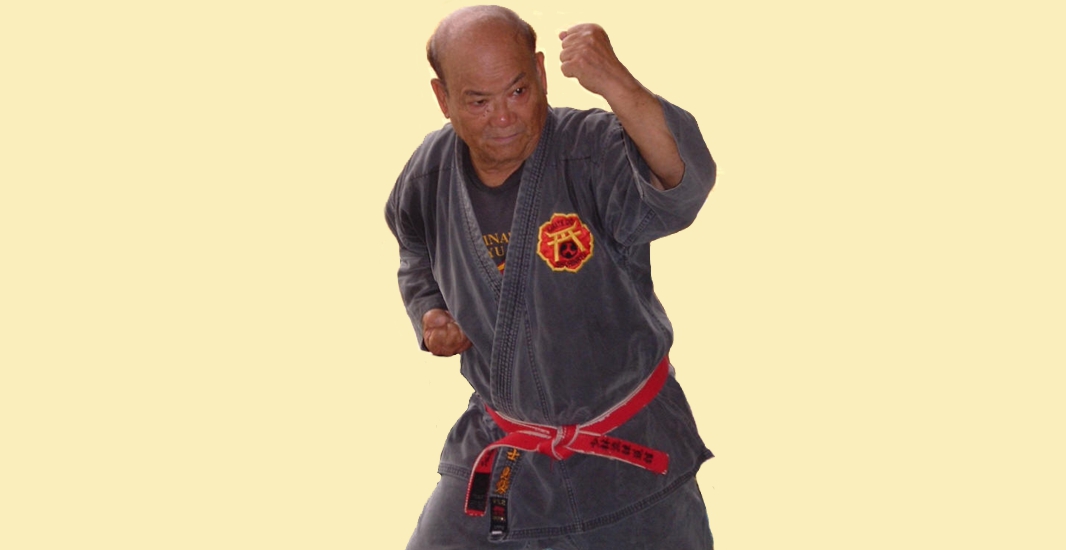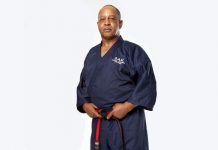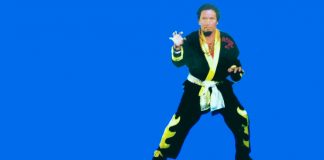This interview was conducted at the Shobayashi-ryu Rendokan Dojo of Eizo Shimabukuro. Shimabukuro is ranked a Shihan 10-Dan and his dojo is located at 4-313 Aza Kin, Kin-cho, Okinawa, Japan. The date of the interview is September 25, 1985. Shimabukuro speaks passable English but one of his younger students who spoke excellent English helped out with the translation.
Identification
My name is Eizo Shimabukuro. I am president of the Shobayashi-ryu Rendokan Dojo and the Okinawan representative for the All Japan Karatedo League (Zen Nippon Karatedo Renmei). I was authorized as the head representative by the late Kanken Toyama (an Okinawan living in Japan and founder of the All Japan Karatedo League in 1930. The certificate of authorization was displayed.).
Presently, I have formed my own association for those that practice shorin-ryu (shobayashi-ryu) outside of Okinawa – that is the All Japan Okinawa Shorin-ryu Karatedo International League (the Zen Nippon Okinawa Shobayashi-ryu Karatedo Kokusai Renmei). The former (AJKL) is for members that have trained in Okinawa or are presently training in Okinawa. The latter organization is for students outside of Okinawa or who have never trained in Okinawa.
Background Information
My background — I am the youngest of ten children and I was born in Gushikawa City, Okinawa Prefecture, on April 19, 1925. I teach five days a week. Mondays, Wednesdays and Fridays I teach at my Shobayashi-ryu Rendokan Dojo in Kin Village. On Tuesdays and Thursdays I teach at the Marine Corp Station called Camp Hansen across the street from my dojo. I also have a chicken farm and I raise and sell bonsai trees.
Training Under Chojun Miyagi
I originally began training in goju-ryu under the late Chojun Miyagi. I learned the kata sanchin and seiunchin personally from him. I also learned proper breathing, strength training and the correct karate spirit from Miyagi.
I was introduced to Miyagi by my uncle, Ganeko Shinko. My uncle had been a student of Ankoh Itosu and also knew the younger brother of Miyagi. I think the younger brother ran a butcher shop in Naha City. At that time, Miyagi was one of the most famous karate practitioners in Okinawa and was also known for his great strength. He would often go to his younger brother’s butcher shop and tear sides of beef apart with his bare hands. He had a tremendous grip.
I studied with Miyagi for a little less than two years. This was around 1939 or 1940 – I was about 15 years of age, a good age to start learning karate. Shortly thereafter Miyagi left Okinawa and when to the mainland (Japan). It was during that period of time the Miyagi was developing the present-day methods of goju-ryu.
When I trained with Miyagi, he had no set way of teaching. The first kata I learned was seiunchin and sanchin was considered the basic form and was always practiced. The sanchin method that I teach is the method that he taught me in the early 1940’s and has not been altered.
Nowadays the form is different due to a number of changes – but I do not judge which one is better or more authentic. All I say is that is the form he initially taught me and that is the way I teach it. Miyagi taught according to one’s age, his character, the individual’s commitment, his body type and/or needs.
Concerning goju-ryu, Miyagi stressed the kata sanchin. When you are young, the kata sanchin is excellent for training and for the development of real karate power. As you get older it becomes less needed and can actually do you harm. Miyagi knew that and therefore developed the tensho form for his older students. Since I was never taught that form, I do not teach it.
As far as the sanchin goes, I teach it as part of my curriculum (in shobayashi-ryu) but I only stress the power aspect of the form for the younger students. The older students still must do sanchin but without the intense power used at a younger age. The older student learns the ideas of focus, centering, stability and body shifting. Also, the form is part of Okinawan
history so it must be passed on. As one grows older, one’s power and strength must grow softer and more refined. This is the real karate.
Yes, I also believe that incorrect training in sanchin can lead to an early death. Sometimes older practitioners practice the sanchin form too hard and this causes problems with the internal organs because they become strained. It is like a car engine. When the car is new it can be run hard but as it puts on the miles it does not have that power. If you continue to push the car hard at 60,000 or 70,000 miles (like 60 or 70 years of age) you will severely damage it – just like you would damage your body at 60 or 70 years old. So, train in sanchin accordingly.
During that time I also studied with my older brother, Tatsuo Shimabukuro. He was twenty years older than me and died in 1975. He trained me in the style he called Chan-migwa style. Chan-migwa is the Okinawan nickname for Chotoku Kyan. Tatsuo was also a student of Kyan and had also studied under Miyagi but over a longer period of time. He was the modern day founder of his own system, which he called the isshin-ryu.
Choki Motobu The Monkey
I then became a student of Chotoku Kyan. I learned all my advanced kata from this great master. At the same time I also studied under Choki Motobu. Motobu was considered the best street fighter in all of Okinawa. He was a punching expert and had makiwaras all over his house – I think maybe up to 20 different ones in the various areas like his bedroom, living room, garden, and the entrance gateway. Even while sitting in his outhouse, Motobu would practice his punching!
He, too, left Okinawa and moved to Osaka to work. It was he that stressed strong spirit and fighting. He was a great master. He specialized in the kata naihanchi shodan or simply naihanchi and the kata koryu patsai. He was a fierce grappler and very, very strong in his upper body.
Motobu was of average height (5’5″?) but he had a thick chest and his upper body strength was great. He would commonly be referred to as barrel-chested. It was said that no one in Okinawa was stronger in punching – his specialty was the shoken or the one-knuckle punch. Motobu was always looking for more skillful or powerful punching techniques. He would first hone it on the home makiwara then use the technique against one of his few students. He didn’t have a lot of students because of it. He loved to “bang” on them and this caused a lot of them to drop out. Many can say that they trained with him but few can say they stayed longer than six months. The only one that did was Katsuya Miyahira of Chibana-style shorin-ryu.
Motobu brought great honor to Okinawan karate during his later life when he calmed down. In his youth he was a fighter and loved to fight in the red-light district of Tomari City. He said all you need is two or three good kata and understand them deeply. Develop the fighting techniques from these kata through practice and you will master karate.
Training With Chotoku Kyan
After my two main teachers left (Miyagi and Motobu) I became a student of Chotoku Kyan (also known as Chan Migwa meaning “Small eyed Kyan”). Chotoku Kyan was the most outstanding of all my teachers. He lived and taught in Kadena, Okinawa.
When I first went to Kyan, he did not accept me until I passed his “spirit testing.” This meant that I would be required to do daily chores and just watch training without taking part. This lasted for three months. This was used to test one’s patience – to develop the karate-spirit one must first develop patience. I was sixteen years old – this was, I believe, in 1941.
Sometimes Kyan would train us long into the night. We would start out with hundreds of repetitions of right hand makiwara training. Then he would double it for the left side. After that it would be hundreds of repetitions of blocking and kick/punch counters. He favored all the various kicking exercises so all of the counters had kicks before closing the critical distance.
Kyan was also a bo-jutsu expert and would often demonstrate this expertise at demonstrations – his favorite bo kata was the Sakugawa form. He would also do his unique version of kusanku. All the demonstrations during the War years were to attract students and this was very important for the teachers. So many of the gifted students had left Okinawa and were inducted into the Japanese Army. A year later, I was drafted into the Army but only served in Japan. The war ended and I returned to Okinawa but was jailed in Tengan by the American Occupation Forces.
I started teaching Kyan-style shorin-ryu in 1948. A year later I opened a small dojo in Gushikawa City. I also taught in Chatan and Koza. I then moved to Kin and opened my present Rendokan Dojo. I have a branch dojo in Koza which is run by my son, Eiko.
Kyan’s methods were based on speed and power. He was known for his outstanding kicking ability and his jumping techniques. One time he was known to have jumped from a bridge onto a passing boat. As the boat went under the bridge, he was then able to jump back onto the bridge. This was at least a nine foot jump!
In 1959 Kanken Toyama appointed me his representative. I did not study karate from Toyama but he authorized me to represent him in Okinawa Prefecture.
In 1962-63 I began training under Choshin Chibana. It was he who corrected all of my kata to what I teach and what is done today. My kata, patsai-dai, is exactly as he taught it. There are no changes.
The Relationship With Kanken Toyama
Kanken Toyama was an Okinawa karate master that was given the challenge of uniting all the factions of Okinawan style karate. He was born in 1888 and died in 1966. He was also a school principal and a very influential person in Japan.
In 1930 he founded his honbu karate dojo in Tokyo and called it the Shudokan. Shudokan means “a place where one studies the Way.” In 1933 he formed the All Japan Karatedo League and accepted students from not only Japan but also Okinawa.
In 1959 Toyama asked for representatives to come to Tokyo to demonstrate and be accepted as Japanese karate masters. This request did not only come from him but also from the Ministry of Education who wanted to evaluate the various styles and methods of the Okinawans. The senior instructors of Okinawan karate did not go – for the simple reason that they did not want to be embarrassed and known as failures when they came back to Okinawa. There was much political back-stabbing back then – almost as much as there is today.
I was the only one that decided to go and demonstrate. I demonstrated the Kyan style and basic weaponry of Shinken Taira. Toyama then appointed me his only
representative for the Zen Nippon Karatedo Renmei. I’ve held that post since 1959.
Since the Okinawans were not supportive of these movements that were being made to unite Okinawan karate, the Ministry of Education lost interest and terminated their relationships with the Okinawans. They then focused all their energies on uniting the various factions that were being practiced in Japan. They eventually united the Shotokan, Wado-ryu, Shito-ryu and Goju-ryu. These are now the main styles of Japan. In Okinawa – well, all they have is the umbrella organization for the Naha group. This is the Zen Okinawa Karatedo Renmei.
Recommendations
Look deeply into kata, there is much hidden there so the kata must be repeated hundreds and thousands of times to get a true and correct understanding. Don’t get bored in training – experiment with different techniques but do not change the kata. Boredom is overcome through self discipline. Seek knowledge. Knowledge doesn’t come to you, you must go out and look for it.
Shorin-ryu Shobayashi-ryu
Shorin-ryu is based on the external systems of Chinese karate while goju-ryu is based on the internal systems. The external systems base their methods on speed and agility while the internal systems base them on strength and stability.
Sokon Matsumura is the most famous practitioner of shorin-ryu. He is credited with formulating today’s naihanchin series, patsai series and kusanku series of kata. Matsumura is often referred to as the Bushi. Bushi means warrior but in Okinawa it means much more than a simple warrior. To us Bushi means that you are also a gentleman — a gentleman warrior. You are well versed in the martial arts like karate, weaponry and writing. This is a total martial artist. The last real Bushi was Miyagi. He was often referred to as Bushi Miyagi because people had great respect for him.
I studied Okinawan kobudo under Shinken Taira. He was an expert in all traditional weapons of Okinawa. You must first learn karate before you can begin to understand weaponry. My two most famous and best students have been Joe Lewis and my son, Eiko Shimabukuro. He runs a dojo in Koza City, Okinawa.
The Spirit of Bushido
By Shimabuku Ezio
The duty of Bushido is
Loyalty of Mind and Courage in spirit.
Faithfulness is even heavier than mountains,
So be determined that death is a lighter one.
And attach great importance to courtesy:
Respect your seniors, and love your juniors.
And always think that reconciliation must
Above all come first.
Valor is the honor of our country from the olden days;
Endeavor hard and make every effort you can,
But restrain yourself from being rude;
Train hard to foster courage and consider well.
Being very true to your word is the real flower of Bushido.
So ponder deep for the future and never make a mistake.
Never trifle anything away,
But get everything carefully arranged.
Once Justice finds the WAY, meekness is better than strength.
Be soft and meek, but be very careful
When you are confronted with your enemy:
Just like the words say.
Loyalty to our lord, and filial piety to our parents.
Never be beaten by others nor beat others.
If you live in this type of a bright society
It is the very flower of Bushido.
Shimabukuro Eizo
Aug 4, 1965






